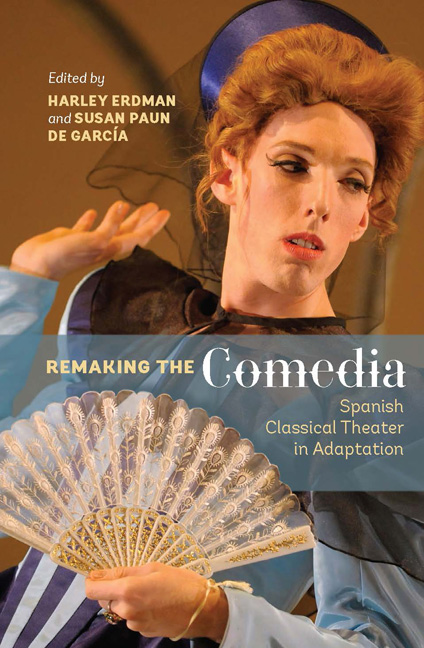Book contents
- Frontmatter
- Contents
- Illustrations
- Contributors
- Preface
- Note to the Reader
- Acknowledgements
- PART I THEORIZING
- PART II SURVEYING
- PART III SPOTLIGHTING
- PART IV SHIFTING
- 21 Porous Boundaries: novela or comedia?
- 22 Lope de Vega and Lenfilm: The Dog in the Manger's Cross-Cultural Journey
- 23 Classical Theater and Puppetry: La Máquina Real
- 24 Remaking Moreto's El desdén con el desdén: From Author's Text to Director's Text
- 25 Lope's Peribáñez on the Lyric Stage
- 26 A Musical Marta
- Play Titles Cited
- Works Cited
- Index
24 - Remaking Moreto's El desdén con el desdén: From Author's Text to Director's Text
from PART IV - SHIFTING
Published online by Cambridge University Press: 05 December 2015
- Frontmatter
- Contents
- Illustrations
- Contributors
- Preface
- Note to the Reader
- Acknowledgements
- PART I THEORIZING
- PART II SURVEYING
- PART III SPOTLIGHTING
- PART IV SHIFTING
- 21 Porous Boundaries: novela or comedia?
- 22 Lope de Vega and Lenfilm: The Dog in the Manger's Cross-Cultural Journey
- 23 Classical Theater and Puppetry: La Máquina Real
- 24 Remaking Moreto's El desdén con el desdén: From Author's Text to Director's Text
- 25 Lope's Peribáñez on the Lyric Stage
- 26 A Musical Marta
- Play Titles Cited
- Works Cited
- Index
Summary
As a professor and director, I aim to include the perspective of a present-day spectator in my staging process, in order to establish connections between what happens on stage and the reality of the society for which the play is performed. In 2008 I directed Agustín Moreto's El desdén con el desdén at the Escuela Superior de Arte Dramático de Murcia, a production that toured numerous festivals throughout Spain, the United States, and Mexico for two years. I aimed for an aesthetic position and a style—in our case, a transposition to the 1950s, including various musical numbers—that would permit the transformation of an important literary text into an attractive vehicle for a contemporary audience. This necessitated a significant intervention into Moreto's text. Moreto's text is, after all, linguistic; its reading is diachronic and linear. However, the play as performed is both linguistic and non-linguistic, given the eminently polysemic nature of performance.
We began the process through careful reading of this amusing, intelligent, and endearing play that takes place in the gardens of a Barcelona palace during Carnival. There, Carlos, Count of Urgel, finds himself in love with Princess Diana, an extremely unsociable enemy of love and marriage. His feigned indifference toward her borders on disdain, but in the end he triumphs over the other suitors and wins her love. In the process, Carlos is aided by the wise counsel of one of the smartest and funniest figures in Spanish Golden Age theater: his servant Polilla.
The theme of this play (c. 1653–54), while not new to Spanish theater of the seventeenth century, finds perfection in this piece. Moreto gives us a masterful work with a streamlined plot free of secondary figures that could cloud the central action. But the core of the work is not simply a fascinating story but also a marvelous intellectual game, a thrilling artifice of ideas.
- Type
- Chapter
- Information
- Remaking the ComediaSpanish Classical Theater in Adaptation, pp. 237 - 244Publisher: Boydell & BrewerPrint publication year: 2015



